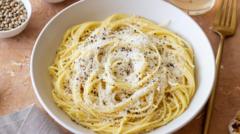A cookbook mishap by Good Food, a UK website, has provoked anger among Italians who are upset over misinformation regarding their beloved dish, cacio e pepe. Traditionalists assert that the dish's integrity hinges on using the correct ingredients, leading to calls for respect of their culinary heritage.
Recipe Blunder Ignites Culinary Outrage in Italy

Recipe Blunder Ignites Culinary Outrage in Italy
The misrepresentation of the classic Roman dish, cacio e pepe, by a UK food website has sparked a national debate over authenticity in Italian cuisine.
Italians are voicing their outrage after the UK-based Good Food website published a recipe for cacio e pepe that many claim strays far from the beloved Roman classic. Emphasized as a quick dish for “a speedy lunch,” the recipe angered purists, particularly because it included ingredients like butter and double cream, which do not belong in this revered dish.
Traditionally, cacio e pepe consists of only three ingredients: spaghetti, black pepper, and pecorino cheese. The inclusion of parmesan and butter prompted an immediate backlash, leading an Italian restaurant association to address the issue with the British embassy in Rome.
Claudio Pica, president of the restaurant association, expressed disbelief that a reputable food platform would showcase such a flawed version of a dish central to Italian culture. “This iconic dish has been a staple of Italian cuisine for years,” Pica stated, emphasizing that it has been replicated globally, further underscoring its significance.
The Italian media has extensively covered the uproar, with some journalists highlighting the gravity of misrepresenting culinary traditions. “We are always told you are not as good as the BBC, and then they go and do this,” lamented one journalist, pinpointing the faux pas as a severe misstep.
Chefs and restaurant owners have further echoed these sentiments. Giorgio Eramo, who owns a pasta restaurant near St. Peter’s, lamented, “It’s terrible! What Good Food published is not cacio e pepe; it’s pasta Alfredo.” Echoing these sentiments, restaurant owners Maurizio and Loredana stressed that using ingredients like butter and cream fundamentally alters the dish and diminishes its authenticity.
While some chefs endorse creativity in culinary creations, many argue that calling a dish cacio e pepe means adhering to its original form. As Nicola, who runs a sandwich shop near the Vatican, emphasized, “Cream should be reserved for desserts.”
Others feel that while the response may be overwhelming, the emotional connection Italians have with their culinary traditions is undeniable. “If you touch the only thing that we have that makes us unique in the world, it makes us sad,” cafe worker Eleonora remarked.
Immediate Media, the parent company of Good Food, has yet to respond to the heated conversation surrounding the recipe and its impact on Italian culinary pride.




















